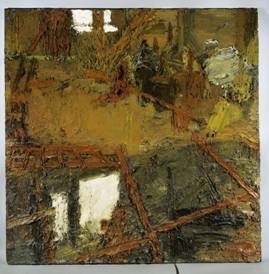Frank Auerbach
dal 15/10/2009 al 16/1/2010
Segnalato da
15/10/2009
Frank Auerbach
The Courtauld Institute of Art, London
London Building Sites, 1952-62. The exhibition explores a group of paintings of post-war London building sites by Auerbach, one of Britain's greatest living artists. The series of fourteen major paintings was produced during the first decade of Auerbach's career and gives a remarkable account of his early artistic development. It was during this period that Auerbach emerged alongside Francis Bacon and Lucian Freud as part of a powerful new generation of British painters.

This exhibition explores an extraordinary group of paintings of post-war London building sites by Frank Auerbach (born 1931), one of Britain’s greatest living artists. The series of fourteen major paintings was produced during the first decade of Auerbach’s career and gives a remarkable account of his early artistic development. It was during this period that Auerbach emerged alongside Francis Bacon and Lucian Freud as part of a powerful new generation of British painters. Frank Auerbach: London Building Sites, 1952-62, on view at The Courtauld Gallery from 16 October 2009 to 19 January 2010, will give the first comprehensive account of these works, which are among the most profound responses made by any artist to the post-war urban landscape.
Auerbach’s years as a young art student in London, from 1947 to 1952, were spent in a city deeply scarred by the aftermath of the Second World War and at the beginning of a long period of recovery and rebuilding. The Blitz had levelled whole areas of London and left numerous buildings severely damaged or destroyed. This wounded landscape was punctuated by remarkable survivals, most famously St Paul’s Cathedral standing defiantly among the ruins. Another spectacular sight was the rebuilding effort which saw armies of workmen clearing the debris and excavating new foundations. Ubiquitous symbols of the rebuilding were the tower cranes which sprang up across the city in advance of the new steel-framed offices and blocks of flats which were to transform London’s urban landscape (fig. 10). For Auerbach, hungry to prove himself as a modern painter, the building sites of London made the most compelling of contemporary subjects. As he recalled recently, “London after the War was a marvellous landscape with precipice and mountains and crags, full of drama… and it seemed mad to waste the opportunity and not to take notice of the fact that there were these marvellous images… all around one”.
Towards the end of his studies at various London art schools including, most importantly, David Bomberg’s inspirational teaching at the Borough Polytechnic, Auerbach began voraciously sketching the city’s building sites, as did his close friend and fellow student, Leon Kossoff. There was, Auerbach says, “a sense of survivors scurrying among a ruined city… and a sort of curious freedom… I remember a feeling of camaraderie among the people in the street”. For Auerbach, the sense of survival must have seemed particularly profound. He had been sent to England from his home city, Berlin, shortly before his eighth birthday and the outbreak of war. Both of his Jewish parents were killed in the concentration camps and Auerbach made London his new home. He combed the city, filling his sketchbooks with details of particular sites, capturing the activities of workmen and machinery as they reshaped London’s bombsites into new structures. He recalls how he would enter a site “by inching along the planks, out over the excavation, just clinging on and dodging the wheelbarrows”. It was the early stages of a construction site that most excited Auerbach, before the building had fully emerged from the ground and there was still a sense of struggle between the formlessness of the raw earth being excavated and the beginnings of architectural order.
Two exceptionally powerful paintings, Maples Demolition, 1960, and Rebuilding the Empire Cinema, 1962, mark the end of Auerbach’s building site series. The works’ palettes of strong yellows and reds contrast with his earlier paintings in the group which were painted in earth tones, as they were the only colours he could afford in the large quantities he required. These two paintings epitomise how Auerbach vividly translates chasms of mud and shored-up earth, cranes, scaffolding and the workmen of the building sites into paintings which capture a powerful sense of the destruction and reconstruction inherent in the redevelopment of London’s bomb sites. His heavily worked, thick surfaces express the material character of the sites; a painted equivalent of the mountains of earth and rubble being excavated and reshaped across the city. His own labours with paint over many months approached the timescale of the buildings themselves. In certain cases the buildings had been erected and opened by the time Auerbach had completed his paintings of their foundations.
The exhibition will bring together Auerbach’s building site paintings, drawing on public and private collections nationally and internationally. It will also display a selection of Auerbach’s few surviving pencil sketches (most of which he destroyed) together with oil studies to reveal the artist’s complex creative process. Research for the exhibition has been greatly enriched by interviews conducted with the artist especially for this project.
Image: Frank Auerbach, Rebuilding the Empire Cinema, Leicester Square, 1962
Oil on board, 152.5 x 152.5 cm
Private collection
For further information, press texts and images, please contact:
Sue Bond Public Relations
Tel. +44 (0)1359 271085, Fax. +44 (0)1359 271934
E-mail info@suebond.co.uk, Website. http://www.suebond.co.uk
The Courtauld Gallery
Somerset House - Strand, London
Daily 10.00 – 18.00 (last admission 17.30)
Admission Adults £5, Concessions £4



